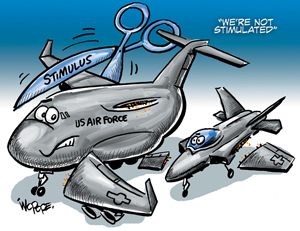 |
|
Would a huge new dose of military spending help stimulate the flaccid US economy? The Obama Administration, for its part, seems of two minds. On one hand, it released to the Pentagon a batch of money for stimulus purposes. On the other hand, it has limited defense spending and has argued over the future of major programs well into the spring.
One who has no doubts about spending more on defense is Martin S. Feldstein, Harvard economist, who said defense spending is uniquely suited to meet America’s current demands. He wrote in the Wall Street Journal that the White House should add a minimum of $30 billion a year to the defense and intelligence budgets during 2009 and 2010.
As the economy headed deeper into recession in recent months, both the Bush and Obama Administrations called for economic stimulus spending that was “timely, targeted, and temporary.”
Obama acknowledges that defense spending can fill an economic need. On March 20, DOD announced it would start 3,000 projects with $7.4 billion it received through the $787 billion American Recovery and Reinvestment Act—the stimulus act.
This spending “is to create jobs and stimulate economic activity across the country,” said the announcement. The projects will “immediately generate additional employment in communities around defense installations.”
The work is concentrated on quality of life improvements such as housing, hospitals, and child care centers. For example: Malmstrom AFB, Mont., anticipates $48 million for projects including improvements to base housing.
After years of flat infrastructure investment, this money is certainly needed and welcome, but DOD’s cut is a pittance: $7.4 billion is less than one percent of the stimulus act’s total spending.
Also, infrastructure improvement projects, while overdue, do little to improve national security. The debate now moves to Congress and centers on how much additional money—if any—DOD should receive.
“We are going to … put the resources where they’re needed,” Obama said, but “make sure that we’re not simply fattening defense contractors.”
Asked whether DOD is taking jobs into account in preparing the 2010 budget, Pentagon spokesman Geoffrey S. Morrell responded, “Not at all. … It’s not the responsibility of this building to worry about the economic impact of budgetary decisions.”
Defense Secretary Robert M. Gates clearly recognizes the role the Pentagon can play in the economy. “It’s not irrelevant that [DOD] employs almost three million people,” Gates said, adding that modernization spending alone “is something on the order of $100 billion” a year—most of which is spent in the United States on American products.
Said Morrell, “This building”—the Pentagon—is under obligation to provide a budget recommendation to the President “in the best interest of our national security.”
“This building” also includes the military services. USAF alone previously identified $20 billion a year in unfunded military requirements; the other services have similar long-term needs. These emerge from a chronic mismatch between missions and money.
Trucks, helicopters, fighters, and transports are all feeling the wear and tear of heavy wartime use. There are, therefore, legitimate arguments for additional defense spending on both national security and economic grounds.
While Feldstein is a fan of defense-spending-as-stimulus, he notes some dangers. An important challenge “is to avoid wasteful spending,” Feldstein wrote. “One way to achieve that is to do things during the period of the spending surge that must eventually be done anyway. … Replacement schedules for vehicles and other equipment should be accelerated to do more during the next two years.”
The Air Force could have put a funding infusion to good use. Instead, the 2010 budget is flat, once adjusted for inflation. But the cuts are concentrated; the gains in areas such as ISR appear more diffuse. Of note:
n Gates calls for F-22 production to end at 187 aircraft, ending 25,000 jobs and placing in peril 95,000 indirectly supported. The F-35 will employ 82,000 people by 2011, and is being boosted over the next five years, but it will be nearly a decade before the F-35 enters service.
n The C-17 line is to be shut down before the long-term reliability of the modernized C-5 fleet is known. Boeing officials say foreign orders may keep production going for a few more years.
n Gates moved to kill the CSAR-X rescue helicopter more than two years after Boeing became the surprise winner of a 141-aircraft contract that Lockheed Martin and Sikorsky successfully protested. Somehow the need for that rescue helicopter is now in question.
n NORAD declared that as old F-15s and F-16s wear out, it will lack enough fighters at its air defense sites. Newer aircraft will have to be assigned to the homeland defense mission, but Gates now suggests sending 250 of these very same fighters to the boneyard.
Defense spending should address valid military needs. Everyone agrees funds should not be used to fatten the defense contractors, and that Soviet-style command economies are a recipe for waste. But the military has significant, pre-existing operational needs that can be addressed through a cash infusion.
Defense spending also preserves domestic science, engineering, and manufacturing jobs at a time when the economy needs them most. The Aerospace Industries Association estimates that the aerospace and defense sector supported two million jobs and ran a trade surplus of $99 billion last year—the largest surplus of any US manufacturing sector.
More information: http://www.defenselink.mil/recovery